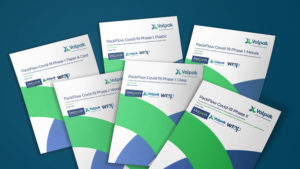Results of updated PackFlow materials reports announced

Despite concerns relating to the potential impact of Covid-19 and the associated restrictions, the report finds that overall compliance with targets proposed in the 2019 packaging consultations will be challenging yet broadly achievable.
Some of the key findings from the updated PackFlow reports are as follows:
- There has been some change to where packing materials are arising coupled with an accompanied change in format type, but broadly this has had less of an impact on the recycling position than may have been feared
- The waste management sector has proved highly resilient and material has continued to move through the recycling process to end markets
- Businesses deregistering due to insolvency as a result of lockdown restrictions could result in an oversupply of Packaging Waste Recovery Notes (PRN’s) due to decreased demand
- Plastics and glass have seen the biggest impact. A decrease in the amount of packaging placed on the market means a potential shortfall in PRNs in the short-term. For plastics, this is compounded by a higher proportion entering households which typically have a lower capture and recycling rate. However, for plastics a higher participation in local authority recycling schemes has outweighed any loss of collections in the commercial sector.
The PackFlow reports cover glass, metals, paper, plastic and wood and are designed to quantify how much packaging is placed on the UK market and subsequently recycled. They are also used by UK governments to inform the setting of business recycling targets. Key findings by packaging material are:
Paper – will continue to deliver surplus PRNs to offset general recycling obligations. A small decline in the material placed on the market and a shift away from the higher participation commercial and industrial sectors towards household consumption is projected.
Glass – volumes of material recycled are likely to be very close to the 2020 obligation. Increased targets mean that compliance in 2021/2022 is likely to require an increased yield from existing systems or improved participation rates. Capture of non-accredited recycling would also help in meeting targets.
Aluminium – faces similar challenges to glass although there are some factors that may help to mitigate the situation including signs of improved participation in collection schemes and the increased capture of non-accredited recycling. New accredited energy from waste capacity will also have a positive impact.
Steel – the compliance position remains well balanced with a small surplus projected. As recycling rates remain extremely high, it is essential that a high proportion of reprocessors are accredited. The projected decrease in POM means surpluses may be eroded and 2022 may see a small shortfall.
Plastic – proposed increased targets may not be achievable. When the participation in recycling systems is kept constant, a small shortfall of PRNs is projected. If a small improvement in participation is modelled, a small surplus is projected. Much of this is not Covid-19 related but associated with broader changes in corporate and consumer behaviour.
Wood – Across all scenarios, the surplus of wood packaging relative to its target narrows in 2020 and then widens in 2021 and 2022.
The updated reports assimilated input from the full spectrum of stakeholders with involvement and support from Defra. Valpak also consulted with the Governments of the devolved administrations and their associated bodies, the Advisory Committee on Packaging (ACP), materials sector bodies, representatives of the waste management sector recycling industry and other Compliance Schemes .
To view the updated Packflow reports – click here.